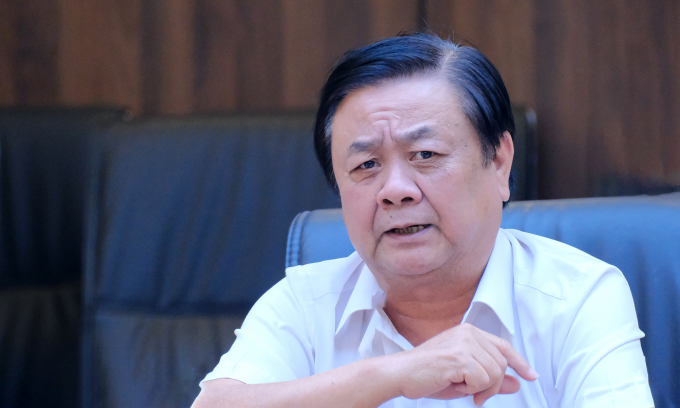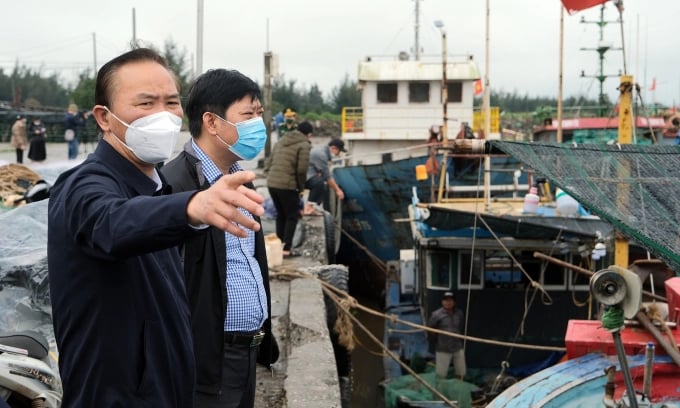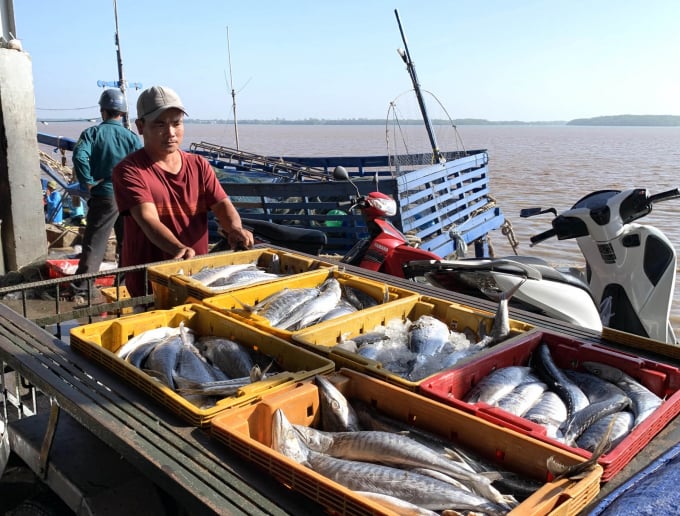May 19, 2025 | 20:16 GMT +7
May 19, 2025 | 20:16 GMT +7
Hotline: 0913.378.918
May 19, 2025 | 20:16 GMT +7
Hotline: 0913.378.918

Minister Le Minh Hoan worked with the Directorate of Fisheries on April 14.
According to the Directorate of Fisheries, seafood resources in 2016-2020 tend to decrease. The fishing force exceeds the allowed output. Exploitation does not ensure the sustainable development of the fisheries industry. In addition, the progress of investment in the construction of fishing ports and anchorages is relatively slow, not meeting the requirements of industrialization and modernization.
Those concerns were shared by the Minister of Agriculture and Rural Development Le Minh Hoan during the working session on April 14. Agricultural sector leaders posed two questions to move toward synchronous and modern planning from 2021 to 2030 with a vision for 2050. The first is which fishing port model is standard and has investment prospects for the future. Second, how to attract investment resources from domestic and foreign enterprises to socialize and professionalize construction works.
"The fishing port in the future must be not only a place for people to make a living or anchor boats but also a living space and a development space for tens of millions of fishermen," the Minister shared.
The minister pointed out that the future model of a fishing port ensures a roof, operator, and sorting area and needs to integrate waste treatment, storage, and inadequate processing facilities and ensure fire prevention and periodic maintenance and repair.
Director-General of the General Department of Fisheries Tran Dinh Luan pointed out some features in the planning of the fishing port system in the coming time, such as reducing the number of fishing vessels to about 83,000; keeping the number of fishing ports of class 1, class 2, and increase the number of fishing ports of class 3 (which was formerly a fishing pier).
Also, the seafood industry will integrate multiple values, from exploitation and processing to tourism linkages, landscape conservation, and marine farming. Based on building five major fisheries centers, the fisheries sector aims to firmly grasp the source of aquatic products through the port, from the species structure, quantity, seasonality, and traceability.

Deputy Minister Phung Duc Tien inspects Cua Lan fishing port, Tien Hai district, Thai Binh.
The country currently has 125 fishing ports, but only 92 ports have been invested in, with about 1.8 million tons total annual throughput. According to the Directorate of Fisheries, according to the 2017 Fisheries Law, there are only 68 ports that meet the announced standards, including 3 ports of class 1, 54 ports of class 2, and 11 ports of class 3.
Not only the Ministry of Agriculture and Rural Development, the Prime Minister, the Government, and many related ministries, departments, and agencies also pay special attention to fishing port infrastructure because this is the center of the fishing value chain, also the place for raw material receiving, production management, and storage organization.
Another problem is that the previous planning of the fishing port system is not commensurate with the speed of fleet development. At one point, the number of fishing boats across the country reached hundreds of thousands. This number has decreased to more than 91,700, but the number of vessels exploiting the high seas increased by about 30%.
In addition to objective factors, there is the fact that some localities out of 28 coastal provinces and cities have not paid due attention to fishing port infrastructure.
In February 2022, the Prime Minister approved the Sustainable Agriculture and Rural Development Strategy for 2021-2030. It is a premise for the agricultural industry to look at itself and improve its values in social-economic development.
As the head of agriculture, Minister Le Minh Hoan wishes to plan the fishing port system in the coming time to contribute to changing the face of the industry and also to help seafood develop sustainably in the direction of increasing farming and reducing exploitation strength.
In the immediate future, the Minister directs the fisheries sector to develop a master plan, issue a set of economic and technical regulations, and invest in public services to guide the locality. In addition, the fisheries sector needs to clearly and flexibly define public-private cooperation toward attracting businesses to accompany the fishing port management boards.

Fishing port infrastructure in many localities has not been synchronously invested compared to the exploitation speed.
According to Deputy Minister Phung Duc, one of the problems that made Decision No. 1976/QD-TTg dated November 12, 2015, "slow" compared to the current development speed of the fleet is the appearance of 24m large ships Tien. By the end of 2021, the number of ships of this type was more than 2,600 (accounting for about 3%). In addition, the number of these ships is unevenly distributed at ports.
"The increased ship length makes the locks built in the 2010s no longer suitable, requiring a synchronous re-planning," commented the Deputy Minister.
In addition to the strategic vision of infrastructure investment, Deputy Minister Phung Duc Tien suggested relevant units to breakthrough thinking in building and developing management models.
Deputy Minister of Agriculture and Rural Development Phung Duc Tien considers this the right time to switch from small and fragmented fishing to responsible fishing.
The two solutions proposed by the agricultural sector leaders to this problem are planning to assess the current situation properly and set the goals close to reality.
Translated by Ha Phuc

(VAN) 14 out of 35 domesticated elephants in Dak Lak province have had their living conditions improved, with 11 of them currently participating in the non-riding elephant tourism model.

(VAN) Muong Nhe Nature Reserve hopes that being upgraded to a national park will lay the foundation for forest protection efforts to be carried out in a systematic, modern, and sustainable manner.
/2025/05/16/3923-2-171845_52.jpg)
(VAN) Lower costs, higher yields, and improved soil quality are outstanding benefits that soybeans bring when integrated into the crop rotation system.

(VAN) The 'For a Green National Environment' programme aims to promote a green lifestyle, support businesses in implementing ESG practices, and turn Net Zero commitments into concrete actions.

(VAN) Cold-barn systems efficiently manage environmental and temperature conditions, which aids in the prevention of respiratory diseases in pigs and protects them from the vectors that transmit African swine fevers.

(VAN) To tackle challenges, the project 'Addressing key technical bottlenecks in the grouper supply chain in Vietnam' has been underway since 2024.

(VAN) The project 'Disease-Resilient and Sustainable Cassava Production Systems in the Mekong Region', funded by the Australian Center for International Agricultural Research (ACIAR), is being implemented from 2024 to 2028.